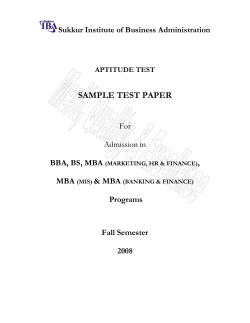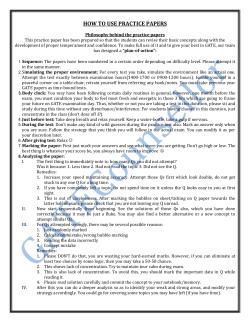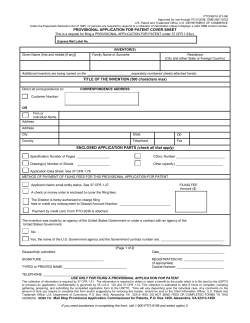
Maximizing and Preserving IP Wealth Through Effective Internal IP Management
Maximizing and Preserving IP Wealth Through Effective Internal IP Management prepared by Jason Cohen My Background • A tech geek, not an IP geek • Managed large scale development and DW environments for large online and financial institutions • Assisted in decision making processes utilizing an analytics based approach • Managed internal improvements utilizing technology and business process solutions • Built multiple IP-based web systems at Ocean Tomo 2 Maximizing IP Value Through Objective Analytics 3 Maximizing IP Value Through Objective Analytics • Common IP Business Questions • What patents should I maintain? • Should I consider a licensing strategy? • Are some of my patents non core and possibly good candidates to sell? • What are my competitors doing? • What acquisitions might strengthen my IP portfolio? • How do I objectively assess the true quality and value of a patent portfolio? 4 Maximizing IP Value Through Objective Analytics • What are companies doing today? • Utilizing search and semantic based tools to find and group patents • Have internal resources review patents on an individual basis • Farm out research to 3rd party companies • Utilize statistical tools like Patent Ratings to objectively assess patent quality and relevance 5 Maximizing IP Value Through Objective Analytics • How to best assess patent quality? • Utilizing known data elements of a patent allows us to create statistical models that can correlate to an effective quality measurement • The semantic based approach is too error prone to be highly effective • Patent data provides a large dataset thereby making modeling of quality and relevance of one patent to the next very reasonable • Patents need experts reviewing them to fine-tune any statistical based approach 6 Maximizing IP Value Through Objective Analytics • Importance of a statistical approach • There needs to be a benchmark to judge initial quality of a patent or portfolio that doesn’t rely on only subjective factors • To truly maximize the value of IP we have to be able to more easily measure it’s quality and value • Combing through large portfolios is time consuming and lacks efficiency • Management needs to know they can trust the analysis 7 Mitigating Risk To Your IP Portfolio Through An Effective Patent Marking Strategy 8 Minimizing Lost Value Due To False Marking Litigation • What is the false marking issue? • On 12/28/09 the Federal Circuit issued its decision in Forest Group v. Bon Tool Company, which allowed for each sold, falsely marked product to carry the $500 penalty • Patent statute, 35 U.S.C. § 292, provides that, where a party marks an unpatented article with a patent number with the intent to deceive the public, “any person” may sue that party to recover a statutory penalty of $500 for “each such offence.” Known as a “qui tam” action, a successful plaintiff must split his recovery with the United States government Presentation Title : TOPIC 1 Topic 2 Topic 3 9 Minimizing Lost Value Due To False Marking Litigation • Why do I care about the False Marking issue? • Significant risk if ANY marking is incorrect • False marking cases are being filed almost daily now • Potentially high damage awards which can be heavily damaging to your IP value • “We just didn’t get around to it” or “we didn’t have the right process in place” might not be a reasonable defense 10 Minimizing Lost Value Due To False Marking Litigation • Barriers to removing any False Marking issues • Poor internal communication between legal, marketing, and manufacturing • Little process to manage the notification that a patent on a product is expiring soon • To date little importance has been placed on this issue • Managing the data needed to easily be able to map a patent to a product 11 Minimizing Lost Value Due To False Marking Litigation • What do I do to remove the barriers and start mitigating my false marking risk? • Make sure the correct internal parties understand this is a very real risk to the organization • Create a group accountable for managing this risk • Understand the manufacturing process and what is required to update product marking • Be prepared for the virtual marking changes in the Patent Reform Act 12 Minimizing Lost Value Due To False Marking Litigation • Prepare for the internal switch to online marking • Create an automated process to manage alerting the internal parties of changes that will impact marking • Create a process to map product-to-patent data so this is something that is easily done moving forward • If internal processes and tools prove difficult to manage/create, use an outside tool like www.patentmarking.com to assist in this process 13 In Conclusion • Internal processes and accountability must be well defined • Stakeholders must understand the importance of an effective internal IP management strategy • Companies must find the right analytics approach that enhances decision making while lowering manpower usage • New risks like false marking are always on the horizon, so preparation and awareness are key 14 Jason Cohen 200 W Madison 37th Floor Chicago, IL 60606 p: 312.327.8157 e: jcohen@oceantomo.com CHICAGO GREENWICH ORANGE COUNTY PALM BEACH SAN FRANCISCO 200 W Madison 37th Floor Chicago, IL 60606 p: 312.327.4400 500 W Putnum Suite 400 Greenwich, CT 06831 p: 203.542.7299 4695 MacArthur Court Suite 1141 Newport Beach, CA 92660 p: 949.798.5610 340 Royal Poinciana Way Suite 317 Palm Beach, FL 33480 p: 561.309.0011 101 Montgomery Street Suite 2100 San Francisco, CA 94104 p: 415.946.2600
© Copyright 2025





















